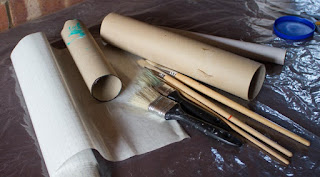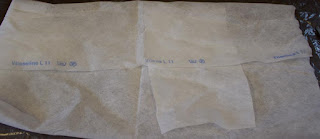Hi, I'm Maggi. Thank you for joining me this month as we take a journey using soy wax to create screens for printing. Before we begin, I will say that I will only be using thickened dye for printing. I have not used acrylic paint or fabric paint so cannot comment if either would work. If you do try acrylic paint, remember to wash your screen out after using it as dried paint on your screen will be there for good. Also use cold water to wash it out, otherwise you will wash away your soy wax and you just might have a design that you want to keep.
I'm going to start with the tools that you need, some of which are essential and others which are optional. Before launching in though you might like a preview of the sort of results that you can get with this technique.
The most essential equipment is the wax and something to heat it with, and of course some screens! You should only use soy wax that is made specifically for this purpose, don't use candle wax. I think that this has been mentioned previously in posts about using soya wax. Try to use a heating pot that has a temperature control and don't leave your pot switched on and unattended. This is the type that I use but you may have something different.
The above screen is one that I made a long time ago. It has printed many yards of fabric so far and is still going strong. You might want to start with a clean screen though!
Other essentials are mark making tools. I like to keep things simple and, as a lot of my screens have circles on them, I have tubes in various sizes. The tubes I use are cardboard and so will eventually deteriorate with the hot wax but you can get quite a bit of mileage out of them. I also like to use a brush for making marks, bristle is preferable but I have often used others and, as long as you don't leave them sitting in the hot wax, shouldn't melt.
In the above photo I also have a roll of self adhesive film (the kind that you use to cover books with). This comes in very handing for creating resists.
If you decide to use a larger brush then you might want to cut into it to make the edge more uneven as this makes for a better mark, unless you want a heavy solid line that is. Just take your scissors and snip into the bristles from the bottom. If you are not sure whether you've done enough then try it out on a piece of paper with some paint or dye.
You can, of course, use any of you favourite tools to make marks, as long as they will pick up the wax to transfer it to the screen.
Thickened dye is also an essential. I find that once it's made up it lasts for a long time but you might want to make up just enough for your sessions.
Fabric. Although you can use these techniques on paper, I'll be using fabric here, silks and cottons. Do remember to soda soak them first and let them dry, otherwise your beautiful results will disappear down the sink. I have a lot of pre-soda'd fabric that was previously dyed so I've been using some of those, as you will see in a later post. If you find that you have made a screen that you really like you could always print it out onto paper and have a thermofax screen made from it, that way it won't take up one of your screens that you could be using for something else.
One other essential item is some lightweight vilene. We won't be using this until later in the month but I thought that if I included it here it would give you chance to find some. It's called by different names in different countries and, fortunately my piece still has the selvedge on with some of the names. It is also sometimes called interfacing.
Optional items:-
A mark making tool that I have wanted for some time is a tjanting and so I decided to treat myself at last so that I could try it out with this series of posts. It's not an essential tool but it does make a finer line.
Sketchbooks which may provide you with inspiration
Something to listen to, music is actually an essential for me but you may prefer listening to your podcasts or audio books, or even prefer silence.
Once you start to print you will also need a padded print surface and a squeegee. If you have done screen printing before then you will no doubt have these, if this is your first time there is plenty of information out there, including in previous posts on this blog.
Have fun getting your supplies together if you are going to play along. On Friday we'll start making those designs on your screens.











Maggi
ReplyDeleteI've used soy wax as a resist but never on a screen so I'm really looking forward to reading your next post.
I've been really looking forward to this Maggi, and so far, your instructions and info have all been very clear, and sound very straightforward. Looking forward to the next stage then. I have everything except the soy wax and something to melt it in. When I worked at the school, I had access to these, but now retired, so time to treat myself too!
ReplyDeleteI've got some soy wax somewhere but no regulated heat pot. I'm really looking forward to following you here this month, Maggi. x
ReplyDeleteHi Maggi,
ReplyDeleteLooking forward to these posts!
What melting pot do you use?
Sandy in the UK (Bracknell)
Maggi, I have been doing soy wax resist for years, and have tried a couple of screens... looking forward to doing more! BTW, for those looking for a solution to what to melt the wax in, I have had a thermostatically controlled deep fryer that I use for about 8 years, and it works great. Plenty of room to dip my tools, even has a basket I can lower and raise with sponge shapes so I don't burn my fingers. Got it very cheap at a local discount store.
ReplyDeleteI've not tried screen printing yet but it's definitely on my list of things to try. Thank you for your excellent and informative post and pictures.
ReplyDeletelooking forward to all the posts this month!
ReplyDeleteSandy, my melting pot is Ranger Melting Pot. I think I got it from the Beetroot Tree so it is probably an Art Van Go one. However, I think Judy's suggestion of a thermostatically controlled deep fat fryer is an excellent one and I'm currently keeping my eyes open at the discount stores!
ReplyDeleteI have one of those Ranger pots but I find it way too small when I'm playing with soy wax! As mentioned in another comment, electric skillets work great. I bought a Presto 11-inch Electric Skillet w/glass lid through Amazon in 2013. I had a hard time finding one locally so opted for Amazon and it was much cheaper back then. Be sure the skillet has a temp control. The 11-inch allows lots of room for potato mashers, tjanting tools and brushes.
ReplyDeleteAnother good suggestion Lynda. I've just compared prices in the UK and the USA for the Presto skillet, bit out of my price range over here. Certainly a larger one is an advantage.
ReplyDeleteI don't understand what you are using for a screen.
ReplyDeleteIs it a special screen?
Thank you,
Merze
Merze, the screen is one that you would use for any screen printing. A wooden frame with fine mesh stretched tightly across it. You will be adding the wax designs to the screen mesh.
ReplyDeleteAn earlier post I wrote disappeared!
ReplyDeleteMaggie, if you can tell me, did you use soy wax straight up or did you mix it with another wax?